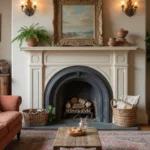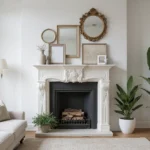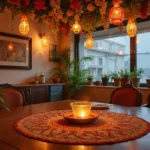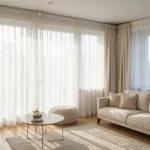Transforming your basement from a dim, forgotten space to a vibrant extension of your home starts with choosing the right paint colors. We’ve researched and tested countless shades to bring you the most effective options that brighten dark spaces, create visual expansion, and complement your existing décor.
Whether you’re creating a cozy family room, home office, or entertainment area, the perfect paint color can make all the difference in how your basement feels and functions. Light neutrals typically work wonders, but some surprising color choices can also transform your underground space into a standout feature of your home. Let’s explore the best paint colors that’ll help you maximize your basement’s potential without sacrificing style or comfort.
Understanding Basement Lighting Challenges Before Choosing Paint Colors
Basements typically receive minimal natural light, creating unique challenges when selecting paint colors. Most underground spaces struggle with small windows, low ceilings, and shadowy corners that can make the area feel confined and unwelcoming. Light behaves differently in basement environments compared to above-ground rooms, often creating color distortion that makes hues appear darker or muddier than intended.
The artificial lighting in your basement dramatically impacts how paint colors will appear on the walls. Fluorescent lights tend to cast a cool blue tone that can make warm colors appear washed out. LED lighting might enhance blues and greens while potentially making reds and yellows look flat. Incandescent bulbs usually create a warm yellow glow that can intensify warm tones while dulling cooler shades.
Time of day affects basement lighting conditions less than in above-ground spaces, presenting both a challenge and opportunity when choosing paint. Without important natural light fluctuations, your basement color will remain more consistent throughout the day. Many homeowners overlook the impact of neighboring structures or landscaping that might block what little natural light could potentially enter basement windows.
Basement layouts often include support columns, exposed pipes, or ductwork that cast shadows and create visual obstacles. These architectural elements can interrupt wall surfaces and create dark spots that make colors appear inconsistent throughout the space. Paint finish selection becomes especially important in these low-light environments, as higher-gloss finishes can help reflect available light but might also highlight wall imperfections.
Understanding these lighting challenges before selecting paint colors helps ensure your basement transformation achieves the desired effect rather than falling flat due to poor light interaction. We recommend testing multiple paint samples directly on your basement walls and observing them under various lighting conditions before making your final decision.
10 Best Light-Reflecting Paint Colors for Basements

Selecting the right paint color can transform your dark, shadowy basement into a bright, inviting space. These light-reflecting options maximize limited natural light while creating an open, airy atmosphere.
Crisp White: Benjamin Moore’s “White Dove”
Benjamin Moore’s “White Dove” stands as a premier choice for basement spaces seeking maximum light reflection. This clean, bright white creates an instantly airy atmosphere without feeling sterile or cold. Many designers recommend this shade for its ability to amplify whatever natural light enters your basement. The subtle warmth in its undertones prevents the space from feeling clinical while still delivering exceptional reflective properties that brighten dark corners effectively.
Soft Gray: Sherwin-Williams “Repose Gray”
Sherwin-Williams “Repose Gray” offers the perfect balance between light reflection and visual interest for basement environments. This gentle, soothing tone brightens spaces without the starkness of pure white. Homeowners appreciate how this versatile greige (gray-beige hybrid) adapts beautifully to different lighting conditions throughout the day. The warm undertones prevent the common basement problem of walls appearing cold or institutional, making it an excellent choice for creating a comfortable atmosphere that still reflects available light.
Pale Blue: Behr’s “Watery”
Behr’s “Watery” brings a refreshing aquatic feel that visually expands basement spaces. This light, airy blue tone reflects available light while adding a subtle hint of color that evokes openness. Decorators often select this shade for basement areas where a sense of expansiveness is desired. The cool undertones work particularly well in basements with warm-toned lighting fixtures, creating a balanced, inviting environment. Pairing this reflective blue with white trim magnifies its light-improving properties even further.
Snowbound by Benjamin Moore
Snowbound delivers crisp brightness with sophisticated gray undertones that maintain warmth in basement settings. This versatile white works exceptionally well for basements that incorporate colorful accent pieces or statement furniture. Designers frequently recommend this shade for its ability to reflect light without creating glare, even in spaces with limited windows. The subtle depth prevents the flatness that can occur with brighter whites in low-light environments.
Origami White by Sherwin-Williams
Sherwin-Williams’ Origami White offers basement owners a warm, creamy white that prevents the cool, shadowy feel common in underground spaces. This inviting shade delivers excellent light reflection while maintaining a cozy atmosphere. Contractors often suggest this option for basements where creating a welcoming environment is as important as brightening the space. The slight yellow undertones combat the bluish cast that can appear in rooms with minimal natural light.
Natural Choice by Benjamin Moore
Natural Choice provides basement spaces with gentle warmth while maximizing limited light sources. This soft neutral creates an instantly welcoming atmosphere in areas that typically feel cold or unwelcoming. Homeowners particularly value this shade for finished basements that serve as entertainment spaces or guest rooms. The light reflective value remains high enough to brighten dark corners while the warm undertones create a space that feels intentionally designed rather than simply bright.
Heron Plume by Sherwin-Williams
Heron Plume introduces sophisticated warmth through its greige base with subtle violet undertones. This multidimensional neutral adds coziness to basement spaces without darkening them. Interior designers frequently select this shade for basements where depth and character are desired alongside brightness. The complex undertones create visual interest throughout the day as lighting conditions change, preventing the flat appearance that can plague basement walls.
Manchester Tan by Benjamin Moore
Benjamin Moore’s Manchester Tan delivers a neutral beige that balances warmth and light reflection beautifully in basement environments. This versatile shade works exceptionally well with various furniture styles and existing color schemes. Realtors often recommend this color for basement renovations aimed at increasing home value, as it creates an inviting atmosphere that appeals to many potential buyers. The warm golden undertones combat the coolness typically associated with below-grade spaces.
Simply White by Benjamin Moore
Simply White offers basement owners exceptional versatility with its bright, clean appearance. This popular shade creates a crisp canvas that maximizes limited light while allowing architectural features or furniture to take center stage. Designers frequently choose this option for basement renovations where a fresh, contemporary feel is desired. The subtle warmth prevents the institutional feel that can occur with cooler whites in basement settings.
Alabaster by Sherwin-Williams
Sherwin-Williams’ Alabaster provides basements with a creamy, warm white that prevents the cool, shadowy appearance common in underground spaces. This inviting shade reliably brightens dark corners while maintaining a soft, welcoming atmosphere. Painters recommend this option particularly for north-facing basements or those with minimal window exposure. The balanced undertones work well with both cool and warm accent colors, making it an exceptionally versatile choice for basement transformations.
5 Cozy, Dark Paint Colors That Work Surprisingly Well Underground

While light colors are often recommended for basements, dark hues can create surprisingly inviting and sophisticated spaces when used strategically. These deeper shades can transform your underground area into a cozy retreat with character and depth.
Navy Blue: Benjamin Moore’s “Hale Navy”
Benjamin Moore’s Hale Navy delivers a deep, rich blue that creates an intimate atmosphere perfect for basement spaces. This sophisticated shade works exceptionally well in media rooms where a darker environment enhances the viewing experience. The depth of Hale Navy provides a speakeasy vibe that feels intentional rather than cave-like. We’ve found this color particularly effective when paired with crisp white trim and warm lighting to balance its intensity. Unlike lighter colors that might wash out under artificial lighting, Hale Navy maintains its character and creates a defined space that feels purposefully designed rather than simply utilitarian.
Forest Green: Sherwin-Williams “Ripe Olive”
Sherwin-Williams’ Ripe Olive brings a lush, natural ambiance that transforms basement environments with unexpected warmth. This deep forest green connects underground spaces to nature, creating a grounding effect that combats the typical “basement feel.” The rich undertones in Ripe Olive work surprisingly well in basement settings, especially when complemented by wooden elements and brass accessories. Many homeowners avoid dark greens underground, fearing they’ll create a gloomy atmosphere, but Ripe Olive actually adds dimension and character. The color’s natural associations help create a cozy den-like atmosphere that feels intentionally designed rather than like an afterthought space.
Deep Red: Dramatic and Inviting
Deep reds create a dramatic basement environment that feels purposeful and designed. These rich tones work particularly well in entertainment areas or wine cellars, establishing a exact themed environment with character. The warmth of deep red counteracts the inherent coolness of underground spaces, making the room feel more inviting even though limited natural light. We recommend using these bold reds on feature walls rather than entire rooms to prevent the space from feeling overwhelming. Their ability to absorb and reflect warm light makes them excellent choices for basements with strategic lighting plans.
Charcoal Gray: Sophisticated Neutrality
Charcoal gray provides a sophisticated alternative to black that adds depth without the heaviness. This versatile neutral creates a modern foundation for basement spaces while hiding imperfections common in underground areas. The subtle warmth in quality charcoal paints prevents the space from feeling cold or damp—a common concern with basement environments. Designers often pair charcoal walls with light furniture and metallic accents to create balance and visual interest. Unlike medium grays that can appear muddy in basement lighting, true charcoals maintain their richness and intentionality.
Dark Teal: Unexpected Elegance
Dark teal brings unexpected elegance to basement spaces with its perfect balance of blue and green undertones. This jewel tone creates a cocoon-like atmosphere that feels both luxurious and comfortable in underground settings. The color’s depth works well in basements with targeted lighting that highlights its rich complexity. Many homeowners report that dark teal creates a sense of expanded space, contrary to the common belief that only light colors make rooms feel larger. We’ve seen this shade transform ordinary basements into sophisticated lounges, home theaters, and game rooms with minimal additional decorating required.
Best Ceiling Paint Options to Maximize Height in Basements

When designing a basement space, the ceiling color choice plays a crucial role in creating the illusion of height and openness. Strategic paint selection can transform a typically low-ceilinged basement into a space that feels airy and expansive. Here are the best paint colors to maximize perceived height in your basement ceiling:
White and Off-Whites
White paint colors are the ultimate choice for basement ceilings as they reflect the maximum amount of light throughout the space. Pure White creates an open, airy feeling that visually pushes the ceiling higher. Cream or Ivory options add a touch of warmth while still maintaining the height-improving properties that make white so effective. These shades work particularly well in basements with minimal natural light, helping to brighten the entire room from above.
Light Gray
Light gray offers an excellent alternative for homeowners who find pure white too stark or clinical. This versatile neutral creates a subtle, sophisticated look without the dramatic effect that can make a space feel confined. Gray tones complement virtually any wall color or design scheme, making them exceptionally practical for basement renovations. The reflective qualities of light gray help disperse illumination throughout the room while providing just enough color to add interest.
Light Blue
Sky Blue and similar light blue shades bring a calming, expansive feel reminiscent of open skies. This color choice works wonderfully to create the psychological impression of height and openness. Light blue ceilings can brighten otherwise dreary basement spaces while adding a subtle decorative element. The cool tones of light blue pair especially well with warm-toned walls and furnishings, creating a balanced and inviting atmosphere.
Factors to Consider When Selecting Ceiling Paint
The effectiveness of your ceiling paint color depends on several key factors. Basement ceiling height should be your primary consideration—lower ceilings absolutely benefit from lighter shades, while rooms with higher ceilings can sometimes accommodate slightly darker tones without feeling oppressive. Natural light availability significantly impacts how colors appear, with darker tones becoming viable options in basements that receive ample sunlight. Always ensure your ceiling color coordinates harmoniously with your wall colors and décor elements for a cohesive design that enhances the entire space.
Waterproof and Mold-Resistant Paint Solutions for Basement Environments

Basements present unique challenges when it comes to moisture control, making specialized paint answers essential for these spaces. Choosing the right waterproof and mold-resistant paint creates a protective barrier that safeguards your basement from common moisture-related problems. Here are some top-performing products designed specifically for basement environments:
Zinsser WaterTite LX Ultra Mold and Mildew Proof Waterproofing Paint stands out as an exceptional option for basement walls. This latex-based formula creates an impermeable barrier against water infiltration while actively preventing mold growth. Its waterproofing capabilities make it ideal for concrete surfaces that may be exposed to moisture.
DRYLOK® Extreme Masonry Waterproofer offers versatile protection for both interior and exterior basement surfaces. The durable waterproof coating resists mildew effectively, providing long-lasting protection for masonry walls. Many homeowners appreciate its dual functionality for various basement applications.
KILZ® Basement & Masonry Waterproofer utilizes innovative nanotechnology to form a robust water barrier on porous surfaces. The advanced formula delivers superior durability against mold development, making it particularly suitable for basements with existing moisture concerns. Its specialized composition addresses the exact challenges of below-grade spaces.
When applying these waterproof answers, proper surface preparation becomes crucial for maximum effectiveness. Thoroughly clean walls, remove any existing mold, and allow surfaces to dry completely before application. Multiple coats may be necessary to achieve optimal protection in particularly damp environments.
These specialized paints work well with the color recommendations mentioned earlier, as many waterproofing products can be tinted to match your desired shade. Combining aesthetic choices with practical moisture protection ensures your basement remains both beautiful and functional for years to come.
Color Psychology: How Different Paint Colors Affect Basement Atmosphere
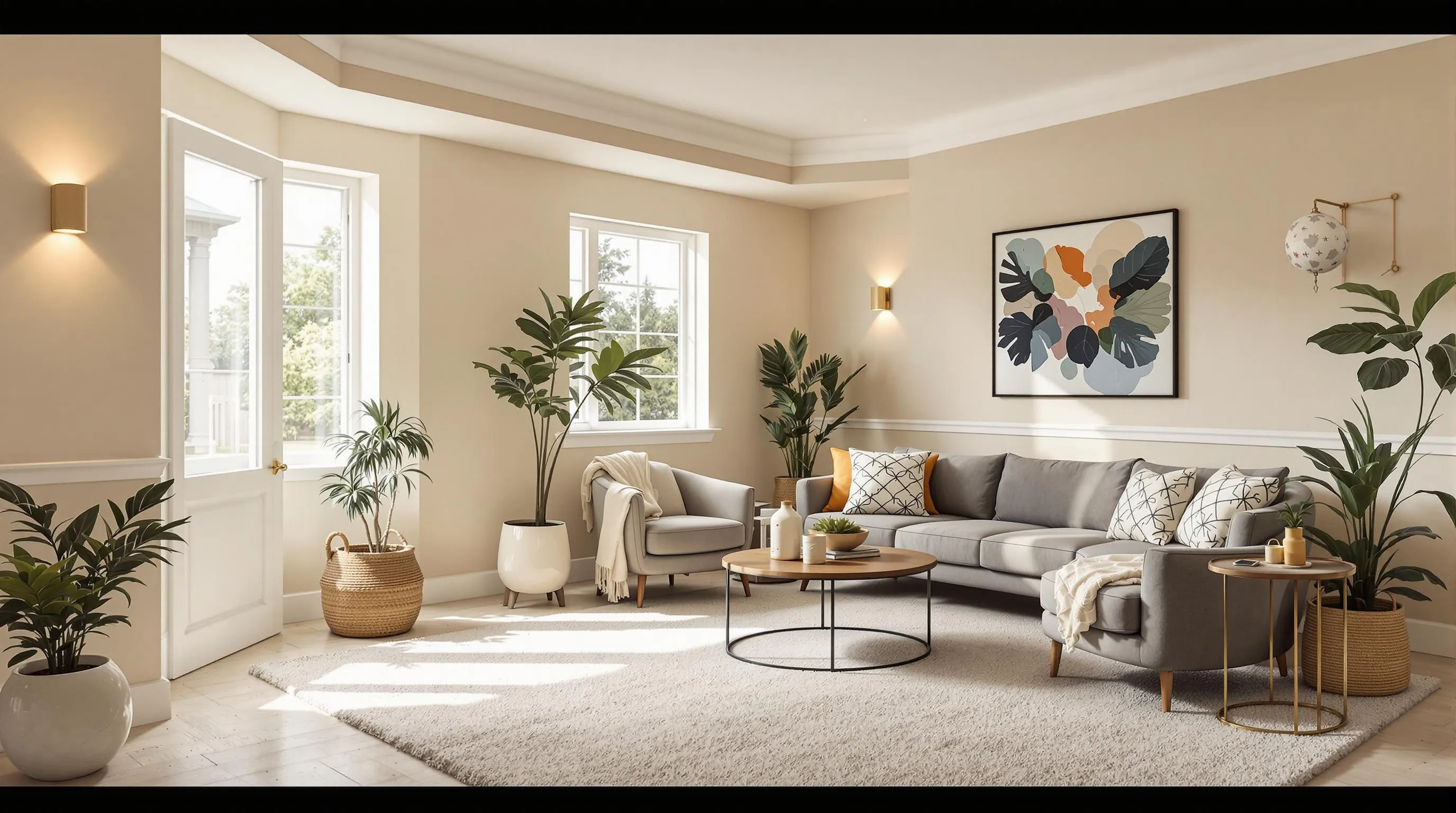
The Impact of Neutrals: Whites and Creams
Neutral whites and creams significantly transform basement spaces by improving perceived brightness and cleanliness. Benjamin Moore White Dove (OC-17) offers a warm, creamy white that prevents starkness while maximizing brightness in typically dim basement conditions. Sherwin-Williams Alabaster (SW 7008) provides a clean white with subtle warmth that avoids the dingy appearance common in underground spaces. Ballet White (OC-9) by Benjamin Moore features yellow and cream undertones that add necessary depth without introducing grayness that can make basements feel cold and unwelcoming.
Creating Coziness: Warm Greiges and Beiges
Warm neutral tones add essential coziness to basement living areas that often lack natural warmth. Benjamin Moore Edgecomb Gray (HC-173) creates a light greige atmosphere that feels inviting without darkening already limited spaces. Sherwin-Williams Agreeable Gray (SW 7029) works exceptionally well with artificial lighting, making it versatile for various basement functions from entertainment spaces to home offices. Manchester Tan (HC-81) by Benjamin Moore introduces an earthy warmth that grounds basement spaces and creates a comfortable environment for extended use.
Mood Enhancement: Cool Tones and Accents
Cool-toned paints can significantly lower stress levels in recreational basement spaces. Sherwin-Williams Sea Salt (SW 6204) presents a soft green-blue that fosters calmness, making it ideal for basement home offices or guest spaces. Watery (SW 6478) delivers a spa-like blue-green effect that promotes relaxation in media rooms or exercise areas. Benjamin Moore Slate Teal (2133-30) provides perfect depth for accent walls without overwhelming the space, adding personality while maintaining balance in the limited confines of a basement.
Strategic Color Selection
We recommend testing colors using peel-and-stick samples like Samplize to observe how artificial lighting affects your chosen shades throughout different times of day. Avoid cross-brand color matching due to potential sheen inconsistencies that can appear more pronounced in basement lighting conditions. Prioritize warm undertones in any color family to prevent cold, sterile atmospheres that can make basements feel uninviting. Deep accent colors should be used sparingly to add personality without overpowering the space or making it feel smaller than it actually is.
How to Test Paint Colors in Your Unique Basement Lighting Conditions
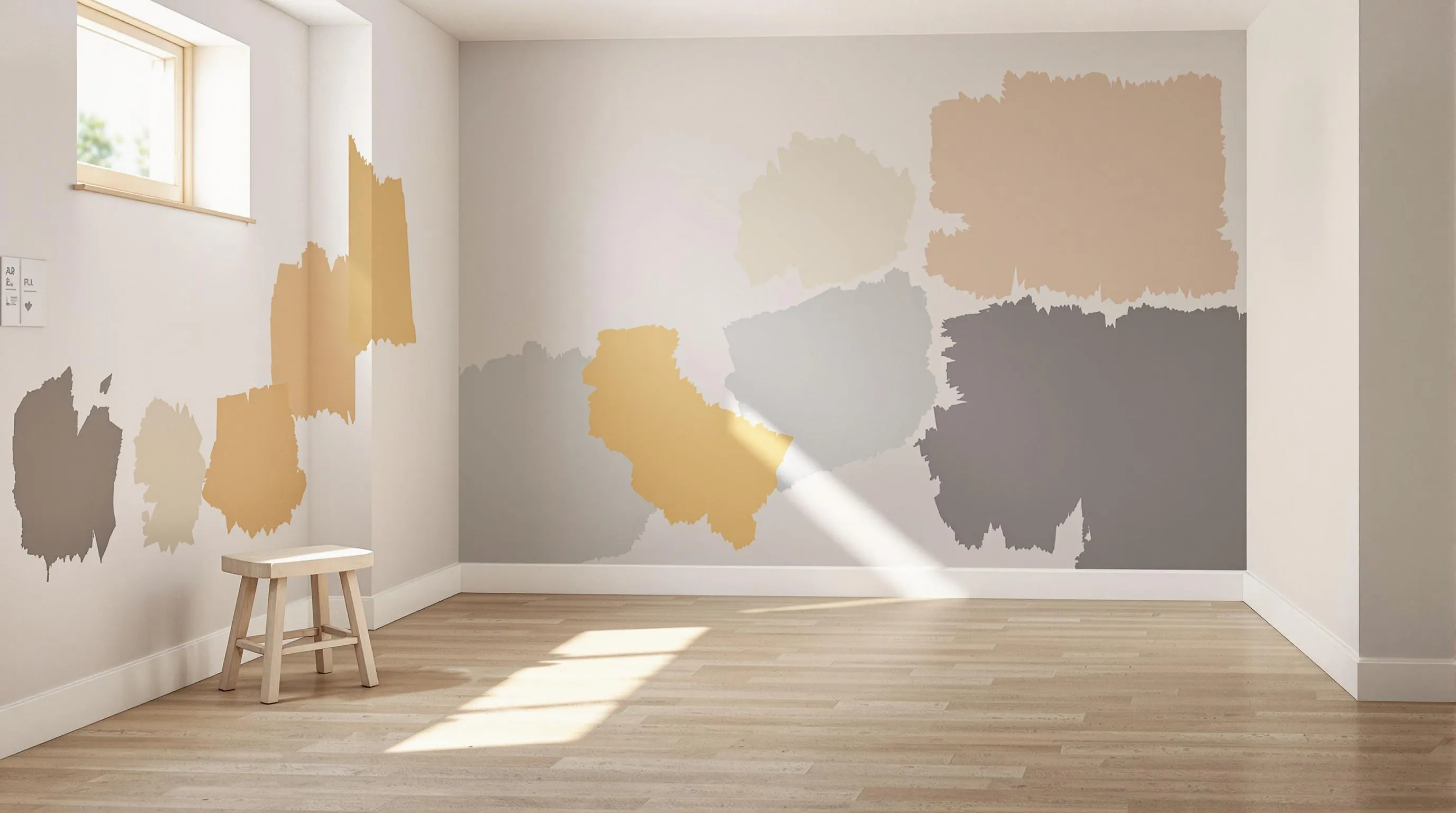
Testing paint colors in your basement requires special consideration due to the unique lighting challenges these spaces present. We’ve compiled proven methods to ensure you select the perfect paint color for your below-grade space:
- Use peel-and-stick paint samples rather than painting directly on walls. Products like Samplize offer real paint samples that won’t damage your surfaces and can be moved to different areas of your basement. This approach lets you evaluate colors without committing to multiple sample cans.
- Observe samples at different times throughout the day to understand how your color choices perform. Check them during daytime hours if you have any natural light penetration, then again under artificial lighting in the evening. Many basement colors that look perfect during the day can appear completely different under evening lighting.
- Test samples on multiple walls throughout your basement space. Lighting conditions vary significantly in basements, especially near windows, stairwells, and dark corners. Moving your samples around helps identify how a color will perform in various locations and prevents unexpected results.
- Compare different paint sheens alongside your color samples. Matte finishes effectively hide wall imperfections but absorb light, while satin or eggshell finishes add subtle reflectivity that can brighten your space. The right sheen can significantly impact how your chosen color appears.
- Avoid cross-brand color matching whenever possible. Paint formulas differ between manufacturers—Sherwin-Williams Agreeable Gray and its Benjamin Moore equivalent often produce inconsistent results. Stick with your chosen brand’s colors to ensure what you see is what you get.
When evaluating potential colors, look for options with Light Reflectance Values (LRV) of 55 or higher to maximize brightness in your basement. Always validate undertones under your exact lighting conditions—colors like Benjamin Moore’s Heron Plume can reveal surprising violet undertones that weren’t apparent in the store. Remember that warm whites like Sherwin-Williams Alabaster will typically outperform cool whites, which can appear stark and uninviting in basement settings.
Coordinating Paint Colors with Basement Flooring Options
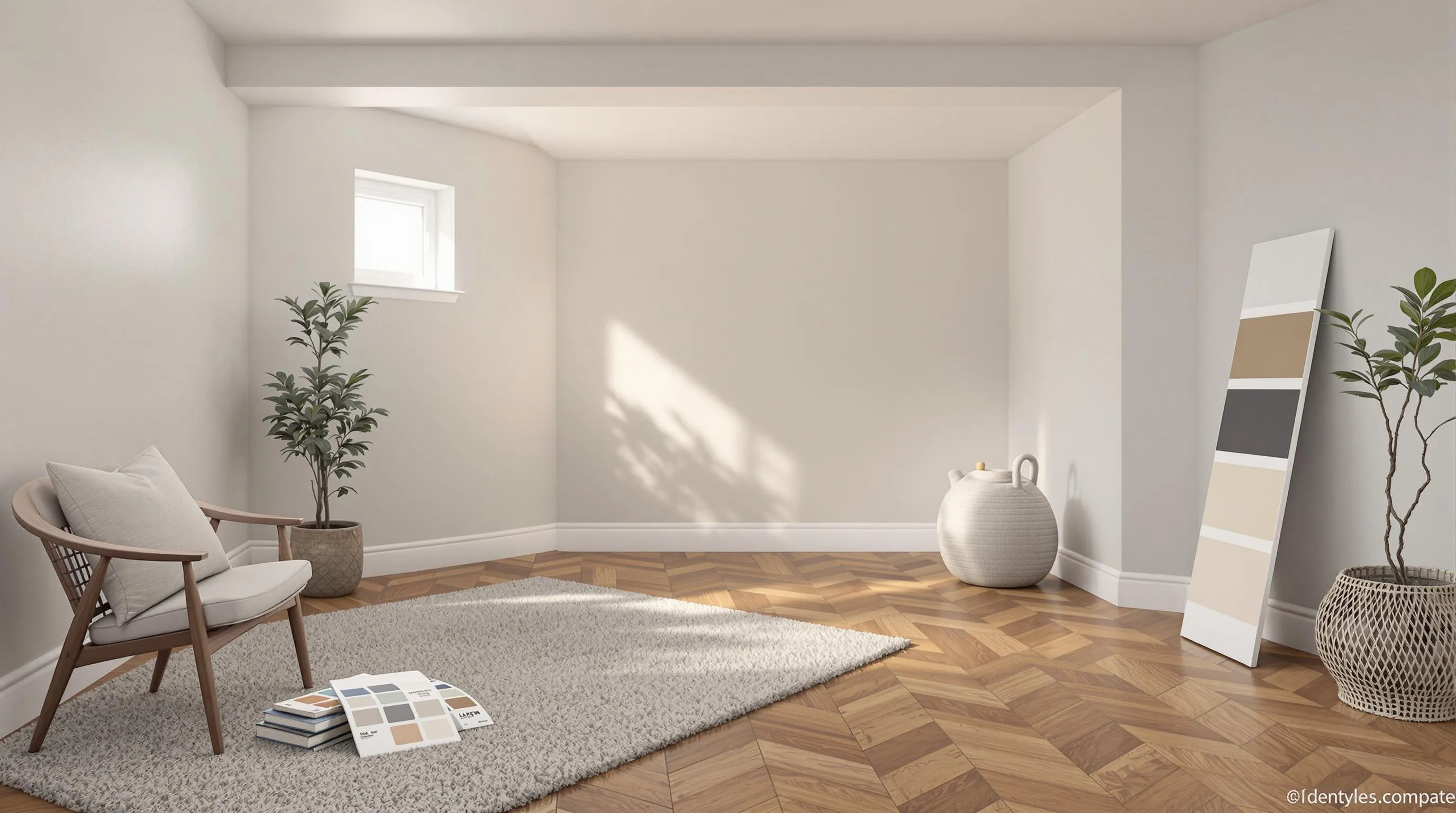
Creating a harmonious balance between your basement’s paint colors and flooring is essential for a cohesive design. The right color combinations can transform your basement into a stylish and inviting space. Here’s how to effectively pair paint colors with different flooring options:
Hardwood Flooring Pairings
Neutral paint colors work exceptionally well with hardwood floors in basements. Benjamin Moore’s Manchester Tan creates a warm, inviting atmosphere that complements the natural tones in wood flooring. Soft grays like Sherwin-Williams’ Agreeable Gray provide a modern backdrop that balances the warmth of hardwood without competing for attention. These neutral options enhance the natural beauty of wood while maintaining a bright, open feeling in your basement space.
Carpet Flooring Combinations
Carpeted basements benefit tremendously from warm whites and off-whites on the walls. Benjamin Moore’s Simply White offers a clean, bright appearance that prevents carpeted basements from feeling dark or closed-in. White Dove by Benjamin Moore provides enough warmth to create coziness without making the space feel smaller. These lighter wall colors create an excellent contrast with carpeted floors, especially in basements where natural light is limited.
Tile Flooring Complementary Colors
Cool-toned paint colors pair beautifully with tile flooring in basement areas. Sherwin-Williams’ Manitou Blue adds a refreshing, calming effect that works particularly well with neutral-toned tiles. Light grays create a sophisticated backdrop for tile floors, especially in basement bathrooms or kitchens where tile is common. The contrast between cool wall colors and structured tile flooring creates visual interest while maintaining a cohesive look throughout your basement.
Testing Before Committing
Always test paint samples directly next to your flooring before making a final decision. Colors can appear dramatically different depending on your basement’s exact lighting conditions and how they interact with your flooring material. Apply sample patches in multiple areas of your basement to see how the paint looks throughout the day with your existing or planned flooring. This crucial step ensures your chosen color combination creates the desired effect in your unique basement environment.
Paint Color Combinations for Multi-Purpose Basement Spaces
Creating the perfect color scheme for a multi-purpose basement requires thoughtful planning to accommodate various activities while maintaining a cohesive look. We’ve compiled expert-recommended color combinations that work exceptionally well in basement environments with limited natural light.
Neutral with Warm Accents
Neutral bases with strategic warm accents create an inviting atmosphere that adapts to multiple functions. Sherwin-Williams’ Agreeable Gray serves as an excellent main wall color, providing a well-balanced neutral background that works in virtually any lighting condition. Benjamin Moore’s White Dove offers another fantastic option, delivering a soft, creamy white that maintains warmth even in low-light basement areas. For accent walls, consider deeper shades like Sherwin-Williams’ Iron Ore or warm beige tones to add visual interest without overwhelming the space.
Crisp White with Deep Accents
For basements needing maximum brightness, Benjamin Moore’s Cloud White delivers a crisp, clean backdrop with subtle gray undertones that prevent the space from feeling sterile. This combination works particularly well in basements serving as home offices or entertainment areas. Adding a strategic accent wall in Benjamin Moore’s Slate Teal introduces a deep, rich color element without making the entire space feel dark or closed in. The contrast between the bright white and deeper accent creates visual depth while maintaining an overall airy feeling.
Monochromatic Neutrals
A monochromatic approach using varying shades of the same color family creates a sophisticated, cohesive look in multi-purpose basements. Benjamin Moore’s Stonington Gray paired with lighter or darker variations like Pebble Beach delivers a versatile palette that transitions smoothly between different functional areas. This approach works particularly well in open-concept basement layouts where visual continuity helps define different zones while maintaining a unified design. The subtle variations in tone add dimension without creating jarring transitions between spaces.
Calming Blues and Greens
Sherwin-Williams’ Sea Salt offers a soft, calming effect that works beautifully in basements used for relaxation or creative pursuits. This versatile color falls between a pale green and light blue, adapting to different lighting conditions throughout the day. When paired with crisp white trim or darker accents like Sherwin-Williams’ Peppercorn, this combination creates a balanced atmosphere that feels both refreshing and grounded.
Warm Neutrals for Cozy Spaces
Sherwin-Williams’ Cultured Pearl provides a warm, light beige that enhances brightness while creating a cozy foundation for basement living areas or guest rooms. This versatile neutral pairs beautifully with both cool and warm accent colors, making it ideal for spaces that serve multiple functions. The warmth of this color helps counteract the inherent coolness many basements experience, especially in below-grade spaces with concrete walls.
Conclusion: Selecting the Perfect Paint Color for Your Basement Project
Choosing the right paint color transforms your basement from a forgotten space into a vibrant extension of your home. We’ve explored how light neutrals brighten dark corners while strategic use of darker hues can create cozy retreats.
Remember that lighting conditions unique to basements significantly impact how colors appear. Taking time to test samples under different lighting conditions will save you from disappointing results later.
Whether you opt for bright whites that maximize light reflection or deep navy for an intimate atmosphere, your choice should balance practical concerns like moisture resistance with your aesthetic vision.
By considering ceiling treatments ceiling height and coordinating with your flooring choice you’ll create a cohesive design that feels intentional and welcoming. With these guidelines your basement can become one of the most loved spaces in your home.
Frequently Asked Questions
What are the best light-reflecting paint colors for basements?
The best light-reflecting paint colors for basements include Benjamin Moore’s “White Dove,” Sherwin-Williams’ “Repose Gray,” Behr’s “Watery,” “Snowbound,” “Origami White,” “Natural Choice,” “Heron Plume,” “Manchester Tan,” “Simply White,” and “Alabaster.” These shades maximize brightness, create an inviting atmosphere, and help combat the typical darkness in basement spaces. White Dove offers maximum light reflection, while Repose Gray provides a soothing tone that works well in various lighting conditions.
Can dark colors work in basement spaces?
Yes, dark colors can work surprisingly well in basements when used strategically. Options like Benjamin Moore’s “Hale Navy,” Sherwin-Williams’ “Ripe Olive,” deep reds, charcoal gray, and dark teal can create intimate, warm, and luxurious environments. These darker hues add character and depth to basement spaces when balanced with proper lighting and thoughtful design elements. The key is using them intentionally to create cozy, inviting atmospheres rather than making spaces feel smaller.
How does ceiling paint affect a basement’s appearance?
Ceiling paint significantly impacts a basement’s perceived height and openness. White and off-white shades maximize light reflection and create the illusion of higher ceilings. Light gray offers a sophisticated alternative while still brightening the space. Light blue can create a calming effect that visually expands the ceiling. Your choice should consider existing ceiling height, available natural light, and overall design scheme to create a harmonious look.
What type of paint should I use for moisture control in basements?
For moisture control, use waterproof and mold-resistant paints specifically formulated for basements. Top performers include Zinsser WaterTite LX, DRYLOK® Extreme Masonry Waterproofer, and KILZ® Basement & Masonry Waterproofer. These products create protective barriers against moisture infiltration while preventing mold growth. Proper surface preparation is essential for effectiveness, and many can be tinted to match your desired color scheme while maintaining their protective properties.
How do different paint colors affect the atmosphere of a basement?
Paint colors significantly influence basement atmosphere through psychological effects. Neutral whites and creams like Benjamin Moore’s “White Dove” enhance brightness and cleanliness. Warm greiges and beiges such as “Edgecomb Gray” add coziness. Cool tones like Sherwin-Williams’ “Sea Salt” promote calmness. Colors with warm undertones prevent sterile environments, while deep accent colors should be used sparingly to maintain balance. The right color choices create specific moods that complement your space’s intended use.
What’s the best way to test paint colors in basement lighting?
The best way to test basement paint colors is with peel-and-stick samples, which allow easy repositioning throughout the space. Test colors on multiple walls and observe them during different times of day with both natural and artificial lighting. Place samples near floors, ceilings, and existing fixtures to see how colors interact with these elements. This approach helps identify how the unique lighting conditions of your basement affect color perception before committing to painting the entire space.
How do I coordinate paint colors with basement flooring?
Coordinate paint colors with basement flooring by identifying your flooring’s undertones first. For concrete floors, cool gray paints complement the industrial look. With warm wood tones, choose paint with similar warm undertones. Carpet flooring pairs well with versatile neutrals that highlight the carpet’s color. For luxury vinyl or tile, pick colors that balance the flooring’s pattern intensity. Create a cohesive look by selecting paint colors that either complement or thoughtfully contrast with your flooring material.
What color combinations work best for multi-purpose basement spaces?
For multi-purpose basement spaces, expert-recommended color combinations include: neutral bases (greige/taupe) with warm accents, crisp whites with deep color accents, monochromatic neutrals for sophistication, calming blues and greens for relaxation areas, and warm neutrals for cozy entertainment spaces. These combinations accommodate various activities while maintaining visual cohesion. The key is establishing a consistent base color throughout the space while using strategic accent colors to define different functional areas.









